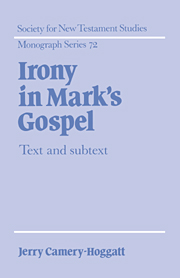Book contents
- Frontmatter
- Contents
- Preface
- List of abbreviations
- 1 Introduction: the problem of irony in Mark
- 2 The social functions of irony
- 3 The literary functions of narrative
- 4 Text and subtext: toward a rhetoric of irony
- 5 The Evidence of Irony in the Gospel of Mark
- 6 By way of summary
- Notes
- Bibliography
- Index
- CITATIONS FROM EXTRA-CANONICAL JEWISH LITERATURE
1 - Introduction: the problem of irony in Mark
Published online by Cambridge University Press: 22 October 2009
- Frontmatter
- Contents
- Preface
- List of abbreviations
- 1 Introduction: the problem of irony in Mark
- 2 The social functions of irony
- 3 The literary functions of narrative
- 4 Text and subtext: toward a rhetoric of irony
- 5 The Evidence of Irony in the Gospel of Mark
- 6 By way of summary
- Notes
- Bibliography
- Index
- CITATIONS FROM EXTRA-CANONICAL JEWISH LITERATURE
Summary
The subtitle of this book – “Text and subtext” – is taken from a discussion of the relationship of language and thought in James Miller's “rhetoric of imagination,” Word, Self, Reality. In that essay, Miller puts his finger on the pulse of the linguistic reality which makes irony possible. The passage in view discusses the view held in theatrical circles that there are often differences of nuance between the surface meaning of the dialogue – the “text” – and the underlying connotative meanings – the “subtext.” Often, the “play” itself resides in the interplay between these two: “When actors come to understand the subtext of the play, they can then give the interpretation that makes for great performances.” Miller's distinction between text and subtext lies at the core of this rhetoric of irony. Irony occurs when the elements of the story-line provoke the reader to see beneath the surface of the text to deeper significances.
Sometimes the two dimensions of stress are extensions of each other, but sometimes they stand at odds. When the former takes place, the basic thrust of the message can be heightened by the congruity with its form; when the latter takes place, the incongruity can evoke reactions which are downright visceral. For this reason, the relationships between text and subtext can be extraordinarily complex or subtle. We are prone to overlook them whenever we insist that the “meaning” of the language can be reduced to a single, unified field of reference.
- Type
- Chapter
- Information
- Irony in Mark's GospelText and Subtext, pp. 1 - 14Publisher: Cambridge University PressPrint publication year: 1992

